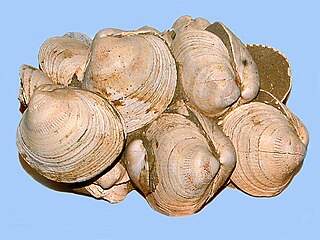
Goniatites is a genus of extinct cephalopods belonging to the family Goniatitidae, included in the superfamily Goniatitaceae. Hibernicoceras and Hypergoniatites are among related genera.

Caturus is an extinct genus of fishes in the family Caturidae. Fossils of this genus range from 200 to 109 mya.

Zaniolepis is a genus of scorpaeniform fish native to the eastern Pacific Ocean. Z. frenata that was a source of food to the Native American inhabitants of San Nicolas Island off the coast of southern California, United States during the Middle Holocene.
Urosthenes is an extinct genus of prehistoric bony fish.
Greenwoodella is an extinct genus of prehistoric bony fish.

Phylloceras is an extinct genus of ammonoid cephalopods belonging to the family Phylloceratidae. These nektonic carnivores lived from Early Jurassic to Late Cretaceous.

Tarasiiformes is an extinct order of prehistoric ray-finned fish.

Desmoceras is a genus of ammonites belonging to the family Desmoceratidae. These cephalopods were fast-moving nektonic carnivores. They lived in the Early Cretaceous; Albian epoch.

Pachydesmoceras is a genus of ammonites belonging to the family Desmoceratidae.

Calycoceras is an extinct genus of cephalopods belonging to the subclass Ammonoidea and family Acanthoceratidae that lived during the Cenomanian stage of the Late Cretaceous, 100-94 Mya. Their shells had ornate ribs.

Belemnites is a genus of an extinct group of cephalopods belonging to the order Belemnitida. These cephalopods existed in the Early Jurassic period from the Hettangian age to the Toarcian age (175.6–183.0). They were fast-moving nektonic carnivores.

Strophomena is a genus of brachiopods belonging to the order Strophomenida family Strophomenidae, named by Rafinesque in 1824. They were stationary epifaunal suspension feeders.

Ampullina is an extinct taxonomic genus of deep-water sea snails, marine gastropod molluscs in the clade Caenogastropoda. These sea snails were epifaunal grazers. They lived from the Middle Triassic period to the Lower Pliocene age.

Lopha is a genus of marine bivalve molluscs in the family Ostreidae.

Glycymeris, common name the bittersweet clams, is a genus of saltwater clams, marine bivalve molluscs in the family Glycymerididae.

Holopea is an extinct genus of fossil sea snails, Paleozoic gastropod mollusks in the family Holopeidae.
Neophylloceras is an extinct genus of cephalopod belonging to the Ammonite subclass.

Metoioceras is an extinct genus of cephalopod belonging to the Ammonite subclass which lived during the Cenomanian.

Pterotrigonia is an extinct genus of saltwater clams, marine bivalve molluscs in the family Megatrigoniidae. This genus is known in the fossil record from the Jurassic period Tithonian age to the Cretaceous period Maastrichtian age. Species in this genus were facultatively mobile infaunal suspension feeders. The type species of the genus is Pterotrigonia cristata.

Parkinsonia is a genus of ammonites belonging to the family Parkinsoniidae.

















